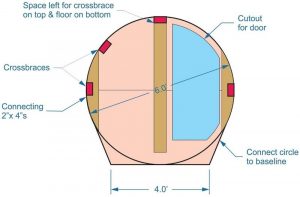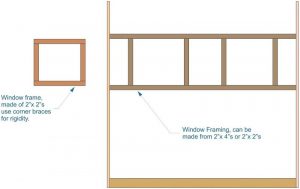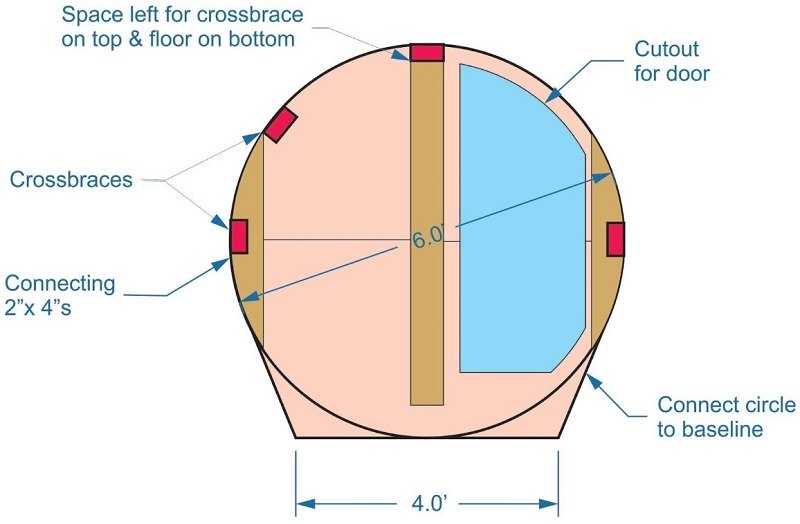Game animals have learned to fear man. This has caused hunters to adopt techniques to make it harder for the animals they are hunting to see or smell them. whether they are deer or turkey hunting or anything in-between, hunters look to use blinds to make it impossible for the game they are hunting to realize that they are there.
This is fairly easy in heavily-wooded areas, where the natural foliage provides considerable concealment. But when you’re out in the plains or even in farmland, it’s much harder to hide a shooting blind. But there is one thing which has proven to be rather effective; hay bales. Animals have become accustomed to seeing those big, round hay bales scattered around the countryside. So when you make your own, they’ll have no way of telling that it’s not a real one.
Properly made, a round bale blind is a perfect cover to hunt from. You can make it as simple or as complicated as you like, even to the point of adding heat to help keep you warm while you are hunting. It all depends on how much work you want to put into it and how much money you want to spend.
Materials Needed
There are several ways of building a hay bale blind, so you might find that you will add some items to this list. But the basic materials consist of:
- ⦁ Plywood – for ends
- ⦁ 2”x 4” framing lumber – for framework
- ⦁ 2”x 2” framing lumber – for windows
- ⦁ Chicken wire or wire cloth
- ⦁ 4 to 8 mil thick plastic sheeting
- ⦁ Straw woven blankets (used for soil conservation and reclamation work)
- ⦁ Hinges for doors and windows
- ⦁ Small corner braces for windows
- ⦁ Exterior grade “drywall” screws (coated to prevent rusting)
Tools Needed
There’s nothing fancy about a hay bale blind, so you don’t need any fancy tools either:
- ⦁ Jigsaw
- ⦁ Circular saw
- ⦁ Drill/driver
- ⦁ Impact driver
- ⦁ Staple gun
- ⦁ Wire cutters
Building the Plywood Frame
The basic frame for the hay bale blind is made out of construction grade plywood and 2”x 4” construction lumber. If you want to, you can upgrade that to pressure treated lumber, but we’re going to be covering the whole thing with black plastic, so it should be waterproof.
Round hay bales are usually about six feet in diameter and five feet wide. You can fudge those dimensions somewhat, as no deer is likely to be carrying around a tape measure to check. But you want to be at least close to those dimensions. Besides, if you get it too big, you might have trouble transporting it to your hunting site.
To start, make the ends of the bale out of plywood. You’ll need to attach two pieces of plywood together, in order to do this, as the plywood is only four feet wide. A simple framework of 2”x 4” studs should suffice for this. Rather than making the hay bale ends exactly round, flatten the bottom side, as shown in the diagram below.

The cutout for the door can be any shape you’d like. I drew it the way that I did, so as to fit between the structural members. The bottom is raised up off the ground several inches, so that it doesn’t get caught up in the grass or snow accumulation. This will also help to keep it drier inside your blind.
You may want to add a floor to your hay bale blind. If you do, this will add considerably to the structural strength of the blind, which is important for moving it. It will also help to keep it dry inside the blind. All you need to do for this is frame it out of 2”x 4”s, laying on edge and cover it with a layer of plywood. I’d recommend using pressure treated lumber for this part, as it will likely have to contend with snow, wet ground and your wet boots.

If you are going to use a floor you’ll need to adjust the height of your center 2”x 4” on the ends, so that it can sit on top of the floor. Attach the ends to the floor by screwing through the plywood into the end 2”x 4” for the floor structure.
Finally, attach a few pieces of 2”x 4” from one end piece to the other, nailing through the plywood and into the end grain of the 2”x 4”. Specifically, you’ll want one at the crown, one in the middle of the back wall, and two on the front wall, so that you can add your windows. These are shown in red in the first diagram, as well as being shown below.

The size and height of your window frames will depend a lot on the kind of hunting you are going to do, and whether you will be sitting or standing inside the blind. Size them as small as you can, while keeping them large enough for you to shoot through comfortably. Keep in mind that you may want to move from side to side, while shooting. The window itself is nothing more than a simple frame, made of 2”x 2”s and used to fill the space when the blind is unoccupied. Make it ½” to 1” smaller than the frame, so that it doesn’t stick, if it warps or swells with moisture.
At this point, you should paint all the wood parts of the hay bale blind, to protect the wood from weather damage. Take special care of the end grain, as that is where water soaks in the best. For best sealing, coat the end grain with painter’s caulk, spreading it around with your finger and allow to dry, before painting.
Finishing the DIY Hay Bale Blind
The wood structure needs a bit of filling out, so that your hay bale blind can take shape. We will do this by attaching chicken wire or welded wire cloth, stapling it to the edge of the plywood ends and the 2”x 4” spacers you attached between the two ends. You don’t want to stretch this tight around the circumference, as that will probably cause you to have some flat spots, but you do want to stretch it tight from end to end.
You will also want to add wire cloth over the window frames, so that you can make the windows match the rest of the blind. At this point, you can also attach the windows and door, hinging them in place and adding the latches. Keep in mind that you will be covering the outside of the structure with a couple of layers, so any latches that need to be added to the outside should probably wait.
With the wire cloth in place, you want to add some waterproofing. This is accomplished by covering the entire structure (less the bottom) with black plastic sheeting, stapling it in place. Be sure when you are overlapping any edges, that you overlap top over bottom, to retain your water-tight integrity.
The final layer is the straw blankets, providing the camouflage of the same color and texture as the hay bales you’re trying to mimic. These are thin, so don’t be surprised if you need to use two layers to ensure that the plastic is covered and doesn’t show through. Don’t overlap the two layers in the same place, but rather, stagger them, using a different pattern for the layout of the top layer, than you used for the bottom one.
Your finished hay bale blind can be picked up by two hunters and hauled in the back of a pickup truck or on a small flatbed trailer, to take it to your favorite hunting spot. Be sure to pick a level spot to set it in, so that you have a stable shooting platform.



